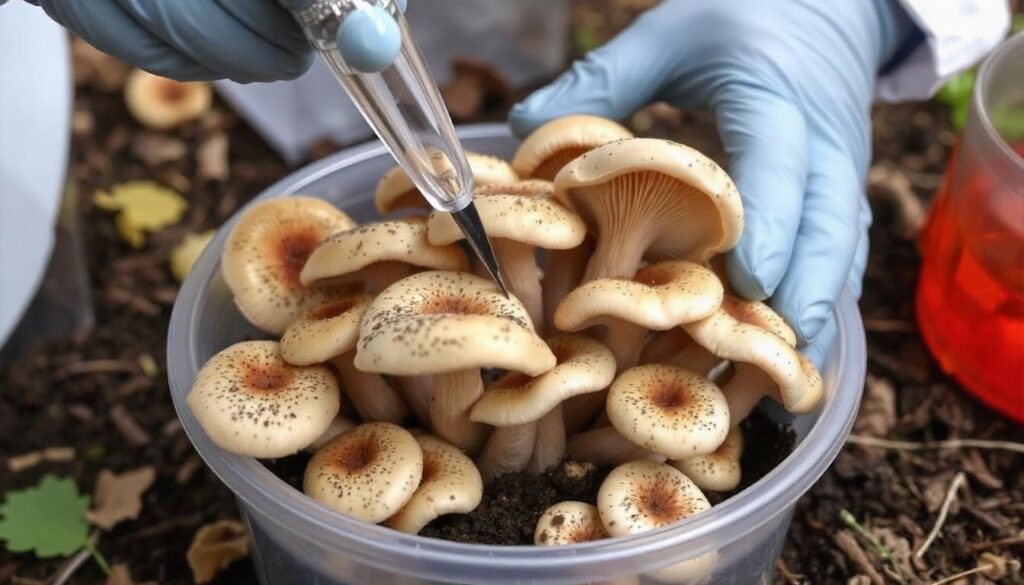

Mushroom inoculation is the process of introducing mushroom spores or mycelium to a growing medium. Think of it as planting the seeds of your future fungi harvest!
In this article, I will guide you in the Inoculation of mushrooms.
Check the steps in sequence.
It is important to select the right spawn to get success in mushroom cultivation. Here’s how to make your choice:
Types of Spawn: Decide between grain spawn, sawdust spawn, or plug spawn. Grain spawn is versatile, sawdust spawn is great for wood-loving mushrooms, and plug spawn is ideal for inoculating logs.
Source: Opt for high-quality spawn from reputable suppliers. Quality spawn increases the likelihood of successful growth.
Tip: Always check for freshness and signs of contamination in the spawn before purchasing.
The substrate is the material that will support your mushroom growth. Preparation is key to a healthy crop.
Selecting Substrate: Choose a substrate that suits the type of mushroom you want to grow. For example, straw and sawdust are common substrates for many species. If you are confused which substrate to choose, read this Best Substrates for Growing Mushrooms at Home
Sterilization: Sterilize the substrate to eliminate competing organisms. This can be done using a pressure cooker or an autoclave. Aim for a temperature of 15 psi for 60-90 minutes.
Tip: Ensure the substrate is cool and dry before inoculation to avoid killing the mycelium.
Inoculation is the process of introducing mushroom spawn to the prepared substrate.
Cleanliness: Work in a clean environment to minimize contamination. Wear gloves and use sterile tools.
Mixing Spawn: For grain or sawdust spawn, mix the spawn thoroughly into the substrate. For plug spawn, drill holes into the substrate and insert the plugs.
Tip: Even distribution of spawn helps ensure uniform colonization.
After inoculation, the substrate needs to be incubated to allow the mycelium to colonize it.
Conditions: Keep the inoculated substrate in a warm, dark place. Ideal temperatures vary by mushroom species, but most prefer between 70-75°F (21-24°C).
Monitoring: Check regularly for signs of mycelial growth. It should look like a white, thread-like network spreading through the substrate.
Tip: Try not to open the incubation area frequently to prevent contamination.
As the mycelium grows, regular monitoring is essential to ensure the health of your crop.
Inspecting for Contamination: Look for unusual colors or odors, which may indicate contamination. If detected, remove affected areas promptly.
Environmental Conditions: Adjust temperature and humidity as needed. Some species require specific conditions to fruit successfully.
Tip: Use a hygrometer and thermometer to keep track of environmental conditions accurately.
Once the substrate is fully colonized, it’s time to trigger fruiting.
Tip: Maintain high humidity and proper ventilation to encourage healthy fruiting.
Let us first discuss the preparation time.
Substrate Preparation: Preparing and sterilizing the substrate can take several hours. For example, pressure cooking grain or sawdust substrates typically takes 60-90 minutes, plus additional time for cooling.
Spawn Preparation: Preparing mushroom spawn, including mixing or shaking, usually takes about 10-30 minutes.
Now move to the Inoculation Time.
Simple Inoculation: For basic inoculation methods (e.g., mixing spawn into substrate), the actual process typically takes 30 minutes to 1 hour. This includes handling the spawn, mixing it thoroughly with the substrate, and ensuring sterile techniques.
Plug Spawn: If using plug spawn, drilling holes and inserting plugs can take about 1-2 hours, depending on the amount of substrate and number of plugs.
We should also consider Post-Inoculation:
Incubation Time: After inoculation, the substrate needs to be incubated. Mycelium colonization generally takes 2-4 weeks, though this can vary based on the mushroom species and environmental conditions.
Total Time for Inoculation Process: From preparing the substrate to finishing the inoculation, you should allocate approximately 1-2 hours for the actual inoculation process itself. The overall preparation time, including sterilization and cooling, could add several additional hours.
When it comes to mushroom inoculation, having the right techniques can make a significant difference in the success of your cultivation efforts.
Grain Spawn Inoculation